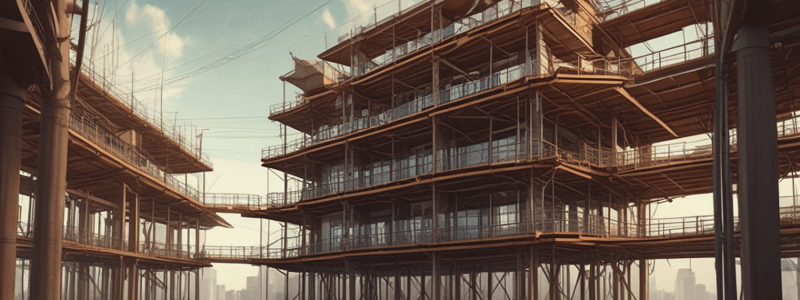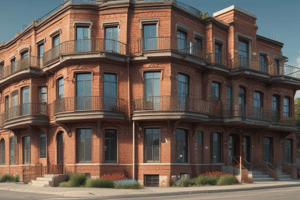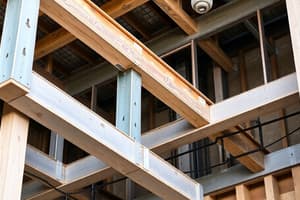Podcast
Questions and Answers
Welche Art von Schäden betrifft die Tragwerkselemente eines Gebäudes?
Welche Art von Schäden betrifft die Tragwerkselemente eines Gebäudes?
- vậtlicher Schaden
- Nicht-strukturelle Schäden
- Umgebungs-Schäden
- Strukturelle Schäden (correct)
Welche Katastrophenart kann zu Gebäudeschäden führen?
Welche Katastrophenart kann zu Gebäudeschäden führen?
- Stürme
- Alle der oben genannten (correct)
- Überschwemmungen
- Erdbeben
Welche Folge kann durch Gebäudeschäden verursacht werden?
Welche Folge kann durch Gebäudeschäden verursacht werden?
- Alle der oben genannten (correct)
- Verletzungsgefahr für die Bewohner
- wirtschaftlicher Verlust
- ökologische Schäden
Wie kann man Gebäudeschäden initial beurteilen?
Wie kann man Gebäudeschäden initial beurteilen?
Wie kann man ein Gebäude gegen zukünftige Schäden schützen?
Wie kann man ein Gebäude gegen zukünftige Schäden schützen?
Was ist ein wichtiger Schritt bei der Vorbereitung auf Gebäudeschäden?
Was ist ein wichtiger Schritt bei der Vorbereitung auf Gebäudeschäden?
What is the primary damage caused by?
What is the primary damage caused by?
Which type of failure mode is characterized by a sudden and complete failure of the system or component?
Which type of failure mode is characterized by a sudden and complete failure of the system or component?
What is the classification of damages based on their impact on the system or component?
What is the classification of damages based on their impact on the system or component?
Which industry is most likely to experience failure modes such as fatigue, wear, and corrosion?
Which industry is most likely to experience failure modes such as fatigue, wear, and corrosion?
What is the term for the subsequent damage caused by the primary damage?
What is the term for the subsequent damage caused by the primary damage?
What is the term for the ways in which a system or component can fail?
What is the term for the ways in which a system or component can fail?
Flashcards
Structural Damage
Structural Damage
Damage affecting the load-bearing elements of a building.
Catastrophic Failure
Catastrophic Failure
A sudden and complete failure of a system or component.
Secondary Damage
Secondary Damage
Subsequent damage that occurs due to primary damage.
Failure Modes
Failure Modes
Signup and view all the flashcards
Loss Assessment
Loss Assessment
Signup and view all the flashcards
Visual Inspection
Visual Inspection
Signup and view all the flashcards
Emergency Plan Preparation
Emergency Plan Preparation
Signup and view all the flashcards
Repair and Retrofitting
Repair and Retrofitting
Signup and view all the flashcards
Severity Classification
Severity Classification
Signup and view all the flashcards
Mechanical Engineering Failures
Mechanical Engineering Failures
Signup and view all the flashcards
Natural Disaster Effects
Natural Disaster Effects
Signup and view all the flashcards
All Consequences of Building Damage
All Consequences of Building Damage
Signup and view all the flashcards
Study Notes
Types of Building Damage
- Structural Damage: Damage to the building's load-bearing components, such as columns, beams, and foundations, which can compromise the building's integrity and stability.
- Non-Structural Damage: Damage to non-load-bearing components, such as walls, windows, and roofing, which can affect the building's functionality and aesthetic appeal.
Causes of Building Damage
- Natural Disasters:
- Earthquakes
- Hurricanes
- Floods
- Tornadoes
- Human Error:
- Construction defects
- Poor maintenance
- Accidents (e.g. fires, explosions)
- Material Failure:
- Corrosion
- Decay
- Cracking
- Settlement
Effects of Building Damage
- Physical Harm: Risk of injury or death to occupants
- Economic Loss: Cost of repairs, replacement, and downtime
- Environmental Impact: Damage to surrounding environment and ecosystem
- Social Impact: Displacement of occupants, loss of community, and social disruption
Assessment and Mitigation of Building Damage
- Visual Inspection: Initial assessment of damage through visual observation
- Instrumental Inspection: Use of specialized equipment (e.g. sensors, drones) to detect damage
- Risk Assessment: Evaluation of the likelihood and potential impact of future damage
- Repair and Retrofitting: Implementing measures to repair and strengthen the building to prevent future damage
- Emergency Preparedness: Developing plans and protocols for emergency response and evacuation
Studying That Suits You
Use AI to generate personalized quizzes and flashcards to suit your learning preferences.




